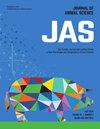Leyla Rios de Alvarez, Zully E Contreras-Correa, Caleb Lemley, Lindsey Dearborn, Peixin Fan, Chuan-Yu Hsu, Brandon Bernard, Michael Pesato, Carlos Sandoval-Castro, Juan Felipe Torres-Acosta
求助PDF
{"title":"Effect of Cottonseed diet on the Performance of Meat Does Artificially Infected with Haemonchus contortus.","authors":"Leyla Rios de Alvarez, Zully E Contreras-Correa, Caleb Lemley, Lindsey Dearborn, Peixin Fan, Chuan-Yu Hsu, Brandon Bernard, Michael Pesato, Carlos Sandoval-Castro, Juan Felipe Torres-Acosta","doi":"10.1093/jas/skaf094","DOIUrl":null,"url":null,"abstract":"<p><p>Gossypol is a phenolic compound found in cottonseed. Phenolic compounds are plant secondary metabolites, known to have both, beneficial and negative effects on animals. The present experiment evaluated the beneficial and negative effects of cottonseed on growth, daily weight gain, parasite infection measured by fecal egg counts, liver function, and ruminal microbiome of growing female meat goats. Forty Boer x Spanish doelings were assigned to 4 groups (n = 10 per group) in a 2 x 2 factorial design consisting of CS-NP cottonseed supplementation (CS) (0.5% body weight-BW in kg) + no parasite infection (NP) CON-NP commercial pellets or control (CON) + no parasite infection (NP); CON-P commercial pellets or control (CON) + Haemonchus contortus artificial infection (P); and CS-P CS supplementation (CS) + H. contortus artificial infection (P). Artificial infection consisted of 4,000 H. contortus infective larvae (L3). The FEC were not affected by diet. The liver function showed a diet by parasite interaction (P = 0.03) for the mean velocity of the hepatic portal vein, which was decreased in CON-P compared with CS-NP indicating a reduction in metabolism. A diet by parasite interaction (P = 0.014) was also observed for the diameter of the hepatic portal vein, which was increased in the CS-P goats compared to all other groups. Liver weights were affected by diet, being decreased in the CS animals vs. the CON ones (P = 0.00), as well as the liver weight relative to the animal's BW (P = 0.01). Diet effect (P = 0.01) was observed for the liver blood flow relative to liver weight. For the rumen microbiome, the number of bacterial species was unaffected by CS but decreased by the parasite challenge (P = 0.03). In conclusion, the supplementation of female meat goats with CS did not affect BW, DWG, parasite infection, and FAMACHA©, but reduced the liver weights, influenced fiber-digesting bacteria in the rumen, and restored lipolytic bacteria in the rumen of goats with parasite challenge.</p>","PeriodicalId":14895,"journal":{"name":"Journal of animal science","volume":" ","pages":""},"PeriodicalIF":2.7000,"publicationDate":"2025-04-04","publicationTypes":"Journal Article","fieldsOfStudy":null,"isOpenAccess":false,"openAccessPdf":"","citationCount":"0","resultStr":null,"platform":"Semanticscholar","paperid":null,"PeriodicalName":"Journal of animal science","FirstCategoryId":"97","ListUrlMain":"https://doi.org/10.1093/jas/skaf094","RegionNum":2,"RegionCategory":"农林科学","ArticlePicture":[],"TitleCN":null,"AbstractTextCN":null,"PMCID":null,"EPubDate":"","PubModel":"","JCR":"Q1","JCRName":"AGRICULTURE, DAIRY & ANIMAL SCIENCE","Score":null,"Total":0}
引用次数: 0
引用
批量引用
Abstract
Gossypol is a phenolic compound found in cottonseed. Phenolic compounds are plant secondary metabolites, known to have both, beneficial and negative effects on animals. The present experiment evaluated the beneficial and negative effects of cottonseed on growth, daily weight gain, parasite infection measured by fecal egg counts, liver function, and ruminal microbiome of growing female meat goats. Forty Boer x Spanish doelings were assigned to 4 groups (n = 10 per group) in a 2 x 2 factorial design consisting of CS-NP cottonseed supplementation (CS) (0.5% body weight-BW in kg) + no parasite infection (NP) CON-NP commercial pellets or control (CON) + no parasite infection (NP); CON-P commercial pellets or control (CON) + Haemonchus contortus artificial infection (P); and CS-P CS supplementation (CS) + H. contortus artificial infection (P). Artificial infection consisted of 4,000 H. contortus infective larvae (L3). The FEC were not affected by diet. The liver function showed a diet by parasite interaction (P = 0.03) for the mean velocity of the hepatic portal vein, which was decreased in CON-P compared with CS-NP indicating a reduction in metabolism. A diet by parasite interaction (P = 0.014) was also observed for the diameter of the hepatic portal vein, which was increased in the CS-P goats compared to all other groups. Liver weights were affected by diet, being decreased in the CS animals vs. the CON ones (P = 0.00), as well as the liver weight relative to the animal's BW (P = 0.01). Diet effect (P = 0.01) was observed for the liver blood flow relative to liver weight. For the rumen microbiome, the number of bacterial species was unaffected by CS but decreased by the parasite challenge (P = 0.03). In conclusion, the supplementation of female meat goats with CS did not affect BW, DWG, parasite infection, and FAMACHA©, but reduced the liver weights, influenced fiber-digesting bacteria in the rumen, and restored lipolytic bacteria in the rumen of goats with parasite challenge.

 求助内容:
求助内容: 应助结果提醒方式:
应助结果提醒方式:


